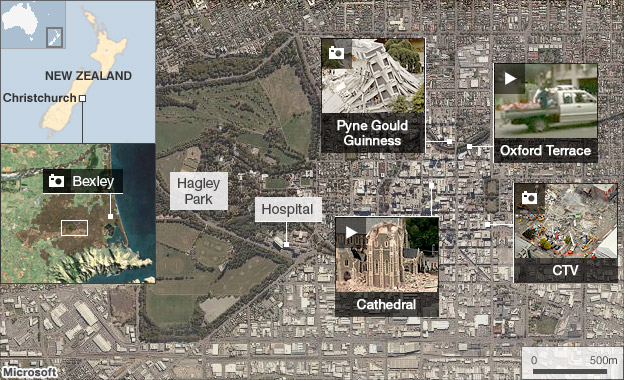New Zealand earthquake: Hopes fade for 200 missing
- Published
New Zealand PM John Key: "200 are feared potentially dead"
Hopes are fading of finding survivors beneath collapsed buildings in the aftermath of Tuesday's earthquake in the New Zealand city of Christchurch.
Ninety-eight bodies have now been recovered and taken to a temporary mortuary. Prime Minister John Key said that number could rise substantially.
Police have said 226 people are missing - up to 120 of them at one site alone.
But they have also insisted it remains a rescue operation and that specialists are still hunting for signs of life.
The earthquake struck at a shallow depth of 5km (3.1 miles) early in the afternoon on Tuesday, when the South Island city was at its busiest.
It was Christchurch's second major tremor in five months, and New Zealand's deadliest natural disaster for 80 years.
'Unsurvivable'
Hundreds of foreign search and rescue specialists - from the US, UK, Japan, Singapore and Taiwan - arrived in the city on Thursday to help police and soldiers combing through the dangerously unstable ruins.
They used sniffer dogs, sound detectors, thermal imaging equipment and cameras to detect any signs of life, but as the day drew to a close there had been none. The last survivor was found on Wednesday afternoon.
Supt Dave Cliff, the police district commander, said there might be up to 120 bodies beneath the collapsed Canterbury Television building, which has been deemed "unsurvivable".
It contained the offices of a local TV station, a language school and a nursing school. The missing include dozens of Japanese, Chinese and Filipino nationals who were studying at the language school.
Search and rescue personnel returned to the site on Wednesday evening, after withdrawing earlier because of the risk of collapse of the nearby Hotel Grand Chancellor, Christchurch's second tallest building.
Another 16 to 22 people are presumed to have died in Christchurch Cathedral, which lost its spire and a section of roof, Supt Cliff said.
Rescue teams have resumed their search of the Pyne Gould Guinness building - the location of the last rescue - after pulling out on Thursday morning because aftershocks were making the structure unstable.
Police have said there may be 20 people unaccounted for inside.
Late on Thursday, several streets in the suburb of Redcliffs were evacuated because of the threat of a cliff collapse.
CLICKABLE Select the images for more details.

Bexley

Streets in the north-eastern suburb of Bexley were flooded as the quake caused water mains to burst, which coincided with heavy rain.
Pyne Gould Guinness

The multi-storey Pyne Gould Guinness Building, which normally houses around 200 workers, collapsed. A number of people were thought to be trapped inside.
Cathedral

The 63m spire of the city's Anglican cathedral was toppled by the earthquake. A New Zealand TV reporter took a look inside the damaged building.
CTV building

Part of Christchurch's Canterbury Television [CTV] building completely collapsed in the earthquake. Some 24 people have been rescued from the building, but police said there might be between 60 and 120 bodies trapped underneath.
Oxford Terrace

In the aftermath of the earthquake, Rhys Taylor took this video on Oxford Terrace, 50 metres away from the city's main hospital. He said: "Cars were being used as ambulances to transport the injured."
Christchurch Mayor Bob Parker said it had been a dreadful day for rescue teams, but that they would continue to check the city centre thoroughly for survivors.
"Miracles happen and we're keeping that in the forefront of our minds. That sort of thing drives you and pushes you on," one of the rescuers, Keith Norton, told the Reuters news agency.
Supt Cliff said a growing number of bodies were being sent to the temporary mortuary.
The names of the deceased would start to be released soon, along with the missing people thought to have been caught up in the disaster, he added. But he stressed that this did not mean they had been killed.
Medical officials said 164 seriously injured people had been admitted to hospital with a range of conditions from crush and spinal injuries to broken bones. The total number injured was about 2,500.
Water tankers
Mr Key said he believed the death toll might rise to more than 200.
With no indication of when the city centre would reopen, Mr Key earlier told reporters the impact on the local economy would be significant.
A JP Morgan analyst has estimated the insurance losses at $12bn.
Christchurch's airport reopened on Wednesday, and military planes were brought in to fly tourists to other cities.
Many residents, meanwhile, spent another grim night camped in evacuation centres. Those still with homes have been told to avoid showering or flushing toilets because the sewerage system is damaged.
Water tankers have been sent to 14 locations throughout the city to allow people to fill buckets and bottles, and 200 portable toilets have been set up. Nine hundred more will be brought in over the next few days.
The electricity supply has been restored to 75% of the city, but officials warned that full restoration could take weeks.
- Published24 February 2011
- Published23 February 2011
- Published23 February 2011